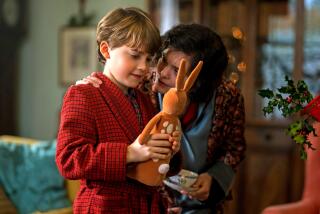The British toddler-TV hit ‘Teletubbies’ has critics babbling. It premieres Monday on PBS.
- Share via
Can four “techno-babies” from Britain topple a big purple dinosaur as tots’ TV superstar and merchandising mega-mogul? Barney is about to find out: “Teletubbies,” a phenomenally successful--and controversial--children’s show in Britain since it debuted there last August, will begin airing Monday on PBS..
Supporters call “Teletubbies” (pronounced “Telly-tubbies”) adorable. Detractors criticize it for targeting a “pre-speech” audience and for its aggressive marketing. Others simply have labeled it bizarre; a host of love/hate Web sites liken the show, geared to children from ages 1 to 4, to a ‘60s psychedelic experience or put forth profound “X-Files”-type theories about the characters’ origins.
The Teletubbies--Tinky Winky, Dipsy, Laa-Laa and Po--are four chubby, costumed characters with TV antennae sprouting from their round heads and TV screens ensconced in their stomachs. They live in a Day-Glo-hued fantasy world “over the hills and far away,” in a “Tubbytronic Superdome.” They eat happy-face toast and machine-generated pink custard. They have a pet vacuum cleaner named Noo-noo and their speech is babyish gabble: “eh-oh” (hello) and “wussat?” (what’s that?).
They giggle whenever their tummy screens light up with video of real kids, and then they ask for instant replay: “again, again.”
Other techno-elements are “voice trumpets” that emerge from the ground to broadcast words and songs, and a windmill that signals the advent of video transmission or computer animation. Over the whole shebang beams a benevolent “Baby Sun” (a real baby).
Its popularity in Britain is such that “if they took ‘Teletubbies’ off, I think there’d be rioting in the streets,” said the show’s proud co-creator, Anne Wood, founder and creative director of Ragdoll Productions.
Indeed, when demand for Teletubbies dolls exceeded supply last Christmas, desperate Brits were willing to pay hugely inflated prices in a thriving black market.
Wood, who created the show with Andrew Davenport, says that every element, from the physical components to the “near and far” concepts and the peekaboo game finale, was crafted to conform to the needs of very young children.
“It started with the idea that children are living in a technological environment,” she said. “Television is the first piece of technology they encounter. It’s a magical box in the corner for them. And they need to be friendly with the screen, they need to be screen-literate as well as every other way literate. So the idea was just to make it a joyful sort of place where you can play.”
In the show’s environment of “play technology,” she said, the Teletubbies, with their TV stomachs, are themselves “a piece of technology” too.
Wood is surprised “that so many adults, many in education,” seem unaware that “we are addressing the area before language is acquired. Because it’s so silly to think you can’t learn anything until you’ve got speech.”
Internationally, some broadcasters have snatched up the series--PBS purchased 40 half-hour episodes in a multiyear deal. Others have emphatically turned it down. Many attendees at last month’s “Second World Summit on Television for Children” in London roundly condemned the show.
According to the London Evening Standard, Ada Haugh, of Norway’s public service channel NRK, called it the most “market-orientated” show she’d ever seen. In the same report, Australian children’s broadcaster Patricia Edgar said the series was “regressive for children who are beyond the babbling stage.”
Wood and other “Teletubbies” supporters, however--including Alice Cahn, director of children’s programming for PBS--are undaunted by such criticism.
“I think it’s wonderful when grown-ups pay a lot of attention to what kids do,” Cahn said, “and television is certainly something that kids spend a lot of time doing.”
The Teletubbies, Cahn said, are “cute, cuddly and nonthreatening, and they provide instant access to an environment that’s understandable, interactive and stimulating.”
To those who question whether children as young as age 1 should be watching television at all, Cahn replies, “They are watching. It’s a fact that broadcasters know, producers know, and it’s a fact that, frankly, as parents we know.”
(Wood often refers to age 2 and older as being the intended audience, but the show’s own press material, as well as Cahn and others, cite age 1 as the starting point.)
Although “no sane person would want a young child to sit in front of the television set for a long period of time,” parents can be comfortable with a half-hour of “Teletubbies,” Cahn said. “Its slow, repetitive pace is in tune with both the cognitive and social development of children as young as 1.
“It also offers parents a lovely chance to interact with their children around a medium we’ve all complained is way too passive. It gives you time to say, ‘What do you think is going to happen next?,’ and it allows your children to make that prediction and feel successful, even if they’re just pointing.”
The only thing about “Teletubbies” that concerns children’s television activist Peggy Charren is “how peculiar it is to design a program for people who have to be propped up to watch it. I find that very disconcerting. There are a lot of better things you can do with babies besides stick them in front of a television set.”
Diana Huss Green, editor in chief of Parents’ Choice Foundation, a nonprofit consumer guide to children’s media and toys, calls the show “weird,” wondering if the “technological” emphasis may give children without frames of reference the idea “that they are little machines, too.”
Nonetheless, Green says, “I knew in 10 seconds it was going to be popular. It’s enticing, the pacing and the repetition are good, and you will have people who will say it may teach words and concepts. But it appears to me to cheerfully teach toddlers that watching TV is cool and buying licensed products is cool.”
The “Teletubbies” team defends the merchandising. “The idea of creating an extension of the viewing experience for the child is very important,” said Kenn Viselman, president and CEO of the itsy bitsy Entertainment Co., “Teletubbies’ ” U.S. representative. It granted Hasbro Inc. the toy and game license for “Teletubbies” in the United States and Canada.
“When you don’t put out any product at all, you’re doing as great a disservice to your audience as putting too much product out into the market,” Viselman said. Moreover, the parents of today’s infants have grown up with TV merchandising. “Young parents not only want it, they expect it,” he said.
Wood feels that with some “Teletubbies” critics, it’s “a sort of Shakespearean thing: They protesteth too much.” Or, maybe, she mused, “they just had a bad time when they were 2.”
*
* “Teletubbies” will air weekdays at 11:30 a.m. on KCET-TV Channel 28, beginning Monday.
More to Read
The complete guide to home viewing
Get Screen Gab for everything about the TV shows and streaming movies everyone’s talking about.
You may occasionally receive promotional content from the Los Angeles Times.






